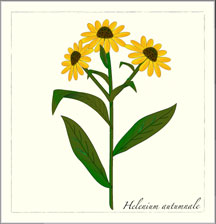Description: This native perennial plant is 3-5' tall, branching occasionally, with ridged stems. The alternate leaves are up to 5" long and 2" across, and clasp the stems. They have a prominent central vein and margins that are smooth or slightly serrate. Their shape may be lanceolate, oblanceolate, or oblong. The numerous composite flowers are yellow and 2-3" across, with a spheroid disk that is quite prominent among the surrounding ray florets. The latter are broader at their tips than toward the base, and doubly notched, creating an interesting effect. They bloom for a month or more, often until late into the fall. The root system is shallow and fibrous.
 Cultivation: The preference is full or partial sun, wet to moist conditions, and a soil that is high in organic material. This plant can appear sloppy and unkempt, particularly if it is allowed to dry out.
Cultivation: The preference is full or partial sun, wet to moist conditions, and a soil that is high in organic material. This plant can appear sloppy and unkempt, particularly if it is allowed to dry out.
Range & Habitat: Common Sneezeweed occurs throughout Illinois, and is especially abundant in the central and northern counties. In many counties of southern Illinois, this plant is less common or absent. Habitats include poorly drained areas of black soil prairies, moist meadows near woodlands or rivers, moist open woodlands, fens, low-lying pastures and abandoned fields, and areas along ditches or lakes. It is not uncommon to find this plant growing within inches or a few feet from water. Recovery from fire is poor.
Faunal Associations: Probably the most common visitors to the flowers are long-tongued bees, including honeybees, bumblebees, Miner bees, and large Leaf-Cutting bees. Other visitors include wasps, butterflies, bee flies, and beetles. These insects seek nectar or collect pollen, although some beetles eat the pollen. The caterpillars of Papaipema rigida (Rigid Sunflower Borer Moth) bore through the stems and eat the pith. Mammalian herbivores usually don't feed on this plant because the foliage is toxic and bitter. There have been reports of severe poisoning for livestock that have consumed this plant, which produces such symptoms as congestion of the kidneys and liver, formation of necrotic areas in the lungs, and irritation of the digestive tract. Not surprisingly, this plant is considered an 'increaser' in grazed meadows.
Comments: Notwithstanding its common name, this plant doesn't cause sneezing or hay fever during the fall – the pollen is distributed by insects, rather than the wind. Common Sneezeweed blooms quite late in the year, providing some fall color when other plants have finished blooming.